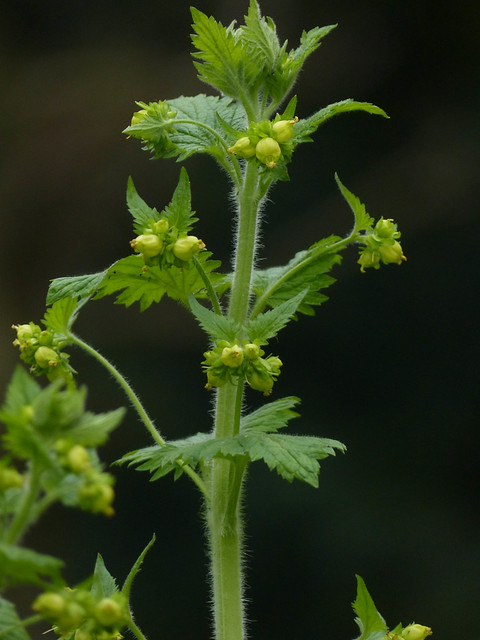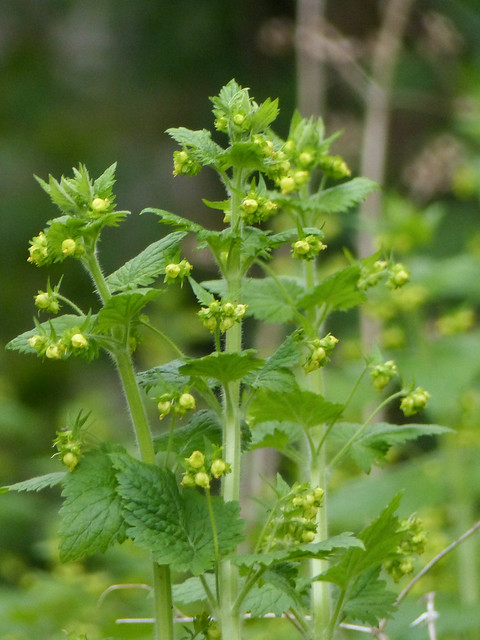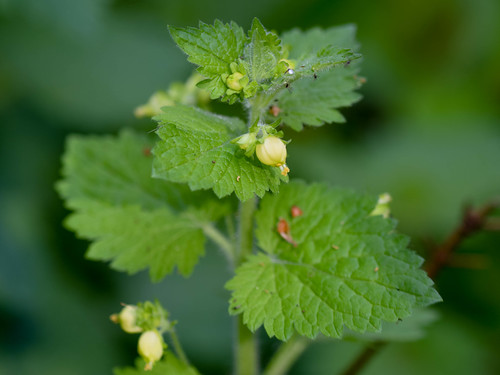 |
| Yellow Figwort: Wallaton Hall Gardens |
Identification
I've looked for it before in that location (the former stables of the Hall), so the conjunction of yellow globular figwort-like flowers and location were very suggestive. When I tweeted this for wildflowerhour I was asked about it:Scrophularia vernalis (Yellow Figwort) RIntroduced. Only recorded growing between the cobbles in the courtyard of the industrial museum in Wollaton Park.
Shepherd (1995:). A Flora of Nottingham.
I don't think it's Figwort. It has reddish brown flowers. 😊— 🌿 Fiona - Green Rhapsody 🌿 (@WildBiophilia) April 29, 2018
So how did I confirm my suspicions? Well firstly, at that point they were still suspicions, but well-founded ones. First of all the simple features, from the photos:
- Opposite-leaved.
- Squarish-stem (most visible on upper parts)
- Hairy stem
- Strongly toothed leaves on long hairy petioles
- Leaves with cordate bases and no stipules.
- Compact almost globular yellow flowers with stamens and style protruding through a narrow opening. Not obviously lipped (either single or double).
- Flowers are in small groups (I hesitate to say whether a cyme or raceme) on long hairy peduncles, and subtended by bracts. Calyx is distinct and the sepals are green.
- No of floral parts
- Ovary inferior or superior & how many cells it contains.
- Presence or absence of latex.
- Smell.
 |
| Stems & flowers. |
A couple of days later I went back and had a much closer look which enabled me to check all the features from both Stace & Poland. I even pressed a bit.
Distribution : General Data & Accounts
 |
| Flowers of Yellow Figwort |
- GBIF. Normally GBIF has enough records for widely distributed European flowers to enable a reasonably accurate appreciation of overall distribution (see this map generated from GBIF for Spiked Rampion, Phyteuma spicatum, and please forgive the misspelt epithet on the image). Unfortunately, this is not the case for S. vernalis. Firstly, British records are disproportionately over-represented, to the point that one might see Scotland as one of the plants strongholds. Secondly, there are quite a few herbarium records from botanical gardens (often a source of outliers on GBIF), presumably the plants were grown in cultivation.
- Flora Europea.This seems to be the source quoted by others for distribution (such as both of Marjorie Blamey's books, Sell & Murrell, etc). It is given as native in Italy (including Sicily), France, Switzerland, Germany, Austria, Hungary, Spain
- iNaturalist: Records from the UK, Belgium and Italy. Obviously iRecord is more heavily used by British Botanists (5/8)!
- Observation/Waarneming: A lot of records, particular in Zuid Holland, but also observations scattered across Central Europe and Italy (Belgium, The Netherlands, France, Germany, Italy and Hungary).
- Alastair Fitter's Atlas of Wildflowers of North-West Europe. My mother bought this book when she was an active field botanist under the tutelage of R.H. Hall in the 1970s. It is still tremendously useful even given the vastly better knowledge of plant distributions which we have these days.
 |
| Fitter's Atlas (Green: native range; Red: casual/introduced; Ecology characteristics above) |
Additionally if the plant is in cultivation there are often excellent horticultural accounts, such as the European Garden Flora (nice, but very expensive), and the Alpine Garden Society's online encyclopaedia.
Distribution: Regional Data & Accounts
I wasn't really sure that the general accounts gave a satisfactory picture of Yellow Figwort's overall distribution. So I resorted to readily available regional accounts:
- Great Britain: Well established with widely scattered locations, see the Plant Atlas and the current BSBI Distribution database. There seem to be a lot of recent records near the east coast of Scotland (including a fellow #wildflowerhour participant the week after mine). Herbaria@home has records of quite a few digitised specimens, including 3 collected in the 1930s at my location by J.W. Carr.
- Ireland: The species is not shown on the BSBI distribution maps, but there is one possible occurrence the 1850s mentioned in the Irish Naturalist Vol 18. for 1909. The location is on the "Ruins of Ballitore", County Kildare (the townland of Ballitore can be seen here on OpenStreetMap). I can't see any obvious ruins on aerial imagery, so one can only speculate about the actual location. Praeger's Irish Naturalists provides some background on the correspondents.
- Belgium: There is a thorough account on the Alien Flora of Belgium site with some useful references. In the main it's distribution is sporadic and although, as in Britain, long persisting it does not appear to be actively spreading.
- Germany. According to Rothmaler, it is a neophyte, first introduced in the 18th century. FloraMap shows known records.
- Switzerland. I only have Flora Vegetativa available as a Swiss Flora and the species is not mentioned. This suggests it is at best a casual. Early accounts (also) in the 19th century merely mention a few sites : Bévieux, Fenalet, Aigle (VS), Bischofszell (TH/SG) and Martigny (VS).
- France. Telabotanica shows both a distribution by Departement and recent observations. Either the distribution or the observations are patchy. It is given a status of native.
- Spain. There are records for Spain held by CISC, but Flora Iberica does not regard it as reliably recorded ("Por todo ello, dado que ni las citas ni los testimonios nos han pa-
recido fiables, hemos preferido no incluir la especie directamente en la síntesis"). It is not present in the regional floras for Catalonia where one of the historical records is located. - Italy. Known to be present in 17 out of 20 regions, with possible presence also in Emilia Romagna. However, I found a charming account of a field meeting around Bergamo which suggests, as in Britain, it is a plant not commonly seen. In general it appears to have a very scattered, albeit widespread, distribution: "The scattered regional distribution is concentrated in the southeastern Julian Prealps, with some stations also in the North-Western Carnic Alps and in the Western Carnic Pre-Alps. It grows in damp woods of deciduous broad-leaved trees, including beech-woods, on rather fresh and humid soils, from about 250 to 1400 m."
- Russia. The account in the Flora of the Soviet Union is available on BHL,. It provides regional locations, but only in European USSR: Upper Volga (Moscow Province), Middle Dnieper, Volga-Don, Lower Don, and Bessarabia.
- Czechia. I have only found one account, for the Jeseníky Protected Landscape Area. It is mentioned in the alongside Ghost Orchid as a rare and unusual plant.
Even after all this delving, a picture of Yellow Figwort's natural range seemed elusive. At best it seems to be native in much of Italy and probably South East France, and presumably extending through the Balkans across Turkey to the Caucasus. It's probably native in Hungary, Austria and Czechia, albeit rather sporadic. Native status in Spain and Germany as listed in Flora Europea looks dubious.
Elsewhere in Northern and Western Europe it would appear to be an escape from cultivation. The Wollaton Hall example suggests that it can persist for long periods at single stations.
Why is it cultivated?
 |
| Close-u p of flowers |
It is not a particularly showy plant, and in general appearance looks rather like Stinging Nettle. In fact I suspect I've missed it in the past because en masse that's exactly what it looks like without a low sun highlighting the flowers.
Thanks to Martin Allen, I learnt that there is one supplier of seeds in the UK: but this is a specialist nursery run by Lady Ro Fitzgerald, a well-known botanist and gardener, so not a run-of-the-mill garden plant. Martin also clearly did not think it deserved garden space.
In general none of the figworts (Scrophularia) are common in cultivation. I suppose people have Water Figwort in garden ponds, but not for the flowers. The European Garden Flora suggests that it is suitable for woodland gardens, but this is the only reference in my meagre library of garden books.
Two other possibilities have occurred to me. The first is that it is a good early season flower for bees; and the second is that it may have been cultivated as a herb. There seems to be good evidence of it's value for bees and other pollinators (I often see long-headed wasps en masse at flowers of Water Figwort); but I can find nothing on any potential herbal properties.
No comments:
Post a Comment